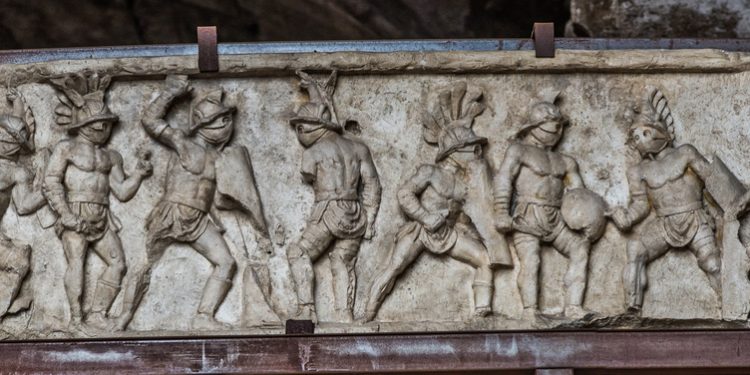What would I not give to be able to go back in time and visit the Colosseum in Rome during a gladiatorial duel?
To hear the sharp sound of steel swords falling on top of each other. To feel the hot tension among the audience with every fiber of your body. To see up close the men who woke up in the morning thinking that there would be no sunset for them… and yet, proudly raising their heads, they greeted the emperor and the spectators.
The arena became a temple, and the warrior a god of war. The ancient Romans knew how to organize fantastic spectacles that made the blood boil and the breath stop.
Gladiators have always been a favorite subject when it comes to Roman history. Unfortunately, most of the stuff you see in movies and read online is untrue. We have already discussed a lot about the truth about ancient roman gladiators. You can read the article here and learn about the origin of gladiators and how they came to be.
Today, however, we will discuss several additional curious facts about ancient Roman gladiators that you deserve to know.
1. Many free citizens wanted to become gladiators for fame and fortune
Initially, most ancient Roman gladiators were war criminals and prisoners, Gladiator games became such a popular and widespread activity that regular citizens began to see it as an opportunity to gain fame and fortune. Therefore, in the later centuries, a large percentage of all gladiators were free citizens, army warriors, or even politicians.
2. Certain Roman Emperors took part in Gladiator games to gain the love of the citizens of Rome
At some point in time, ancient Roman gladiators were so respected and loved by the crowd that Roman Emperors and nobles began to envy them. Several famous Emperors made the decision to fight in the arena to gain the love of the crowd. Such are Caligula and Commodus, for example.
Of course, the participation of the emperors was done after strict preparations and there was a low chance of getting themselves hurt. It was all nothing more than a well-thought manipulation of the crowd.
3. There were several Gladiator classes with different weapons and outfits
The original ancient Roman gladiators had nothing more than a sword or a spear but as the games gained attention and became the most desirable entertainment in Rome, gladiators were divided into classes and were trained individually. Once again, you can read about the different gladiator classes here where we discussed them in-depth.
4. There were female gladiators until their participation was prohibited
You rarely see female gladiators in movies but they existed and in fact, were among the most favorite gladiators for men to see. However, female participation in gladiator games was prohibited in 200 AD by Emperor Septimius Severius.
5. Gladiator games had referees like modern sports
Here is another aspect of gladiator games that you do not see in movies. Much like modern sports, gladiator games had referees. This was critical especially in noble games when the gladiators were there to make a show and nobody was supposed to die. In case one of the participants was heavily injured, the referee could stop the fight and announce a winner.
6. Ancient Roman Gladiators were one of the most expensive businesses
Slavery is a terrible thing but it was one of the greatest businesses in the ancient world. And thus, decent slaves were expensive but even more expensive was to feed and train gladiators whom you own. Therefore, organizers did not want their gladiators to die fast even if the crowd was bloodthirsty. The longer a gladiator lived, the higher the profit for the owner and organizers.
7. All ancient Roman gladiators lived in barracks near the Colosseum
There were numerous gladiator barracks near the Colosseum and many have been excavated by archaeologists. All gladiators lived together and trained for their battles there. Depending on whether the fighters were free folk, slaves, or war prisoners, they would either live in regular rooms or cells.
8. Gladiator games began as a funerary practice
The earliest similar organized events were made to commemorate someone’s passing. People funded such battles as there was a general belief that the spillage of blood will cleanse the soul of the dead. It became such a widespread tradition, that people began to save money to fund a gladiator game for their own funeral.
9. Romans often drank gladiator blood for several purposes
This practice is one of the nastiest Roman beliefs related to gladiators. Since they were so loved and respected by the crowd, citizens began to believe that drinking gladiator blood will give them the strength of the dead gladiator. As you can probably guess, this became a frequent practice and even nobles took part.
Another unethical belief was that gladiator blood had healing powers. Therefore, it was often given as a remedy for epilepsy.
10. Gladiator clothes were extremely revealing
Gladiator clothes and equipment were so scarce that we can generally say that they were fighting almost naked. Even female gladiators had to fight this way and were allowed to hide only the lower intimate parts of their bodies with animal skins.
Join the discussion and participate in awesome giveaways in our mobile Telegram group. Join Curiosmos on Telegram Today. t.me/Curiosmos











